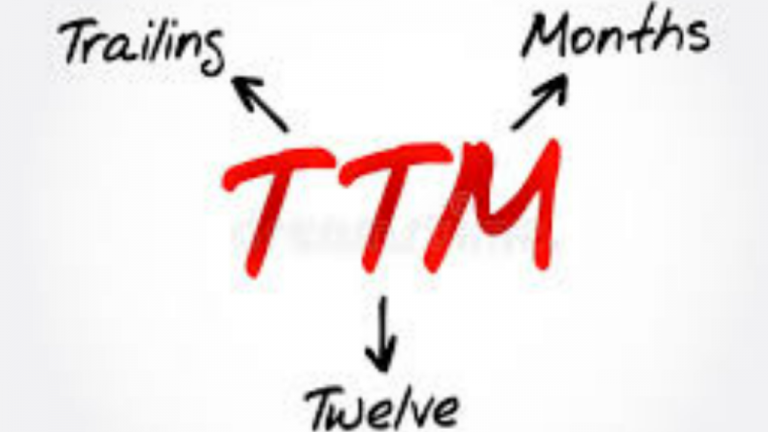As the owner of a company or a stakeholder in the organization, it is essential that you have access to any financial information that may influence the financial decisions made by the organization. Because of this, it is acceptable to utilize TTM data when making a decision, but the most recent financial statement is not accessible. The TTM measurement is a type of financial metric that companies make use of. TTM is determined by applying the reporting entity’s financial statements to the calculation.
Table of Contents
What Does TTM Mean in Stocks?
TTM is an abbreviation for “trailing twelve months” and refers to a firm’s performance over the last year. The term trailing 12 months (TTM) is used to indicate the past 12 consecutive months of a company’s performance data that is utilized to publish financial results. The 12 months examined may not necessarily correspond to the conclusion of a fiscal year.
Analysts and investors utilize TTM to analyze a vast array of financial data, including balance sheet statistics, income statements, and cash flows. The calculation procedure for TTM data may vary between financial statements.
Some analysts in equities research disclose results quarterly, while others do so yearly. However, investors seeking daily information on stock prices and other current data may find TTMs to be more relevant because they are more timely and seasonally adjusted.
Additionally, TTM numbers may be utilized to construct financial ratios. The price-to-earnings ratio, also known as P/E (TTM), is computed by dividing the current stock price by the company’s trailing 12-month earnings per share (EPS).
Much of basic analysis is comparing a measurement to a similar value from a past period to determine the growth level. For instance, a firm with $1 billion in revenue is very outstanding, but this feat is much more remarkable if the company’s revenue climbed from $500 million to $1 billion during the past year. This significant improvement illustrates the company’s growth trajectory.
When examining stocks, investors and analysts examine the TTM to determine the stock’s performance over the last twelve months.
You may better understand the stock’s performance by examining the stock’s performance over the last year by examining the stock’s trailing twelve-month price.
Public corporations provide four quarterly reports and one annual report annually.
When calculating TTM, you account for the stock price change caused by the release of the company’s past four quarterly statements.
Who Requires TTM?
A TTM full-form analysis gives information that cannot be obtained simply by examining the year-to-date financials. Numerous companies are seasonal, thriving during summer tourism, back-to-school shopping, and holiday gift-buying. If Christmas shopping is your peak time, looking at year-to-date revenue in October will not reflect this. Looking at the previous fiscal year will not yield recent revenue information, and a TTM revenue report can accomplish both objectives.
For another illustration, assume that your romantic B&B has its busiest month in February due to Valentine’s Day. Simply reviewing the financial accounts for the month of February does not put the revenue for the month into context. A TTM can display seasonal fluctuations in your income and spending. Two TTMs for a total of 24 months of financials reveal whether or not your Valentine’s business has developed over time.
Using a TTM financial breakdown helps prevent myopia that might result from focusing on the prior month or quarter. A bad quarter might leave you questioning your judgment; a strong quarter can make you overconfident. When seen in the context of the trailing 12 months, things become clearer.
Using TTM in addition to quarterly or fiscal year analysis requires more time and effort. Instead of recording every detail, it may be more economical to focus your TTM data on leading indicators such as revenue, gross profit, and net income.
TTM’s Importance in Finance
Finance procedures are inadequate if there are no metrics displaying pertinent firm information in a recognized way. As a business owner, TTM can assist you in a timely time in gaining a comprehensive understanding of your company’s financial situation. The function of TTM in finance is methodical and vital anytime the company’s yearly metrics are out-of-date or when there has been a recent increase in profit or growth.
The purpose of TTM in finance is to maintain track of financial measures and data that can be used to compare performance over time periods. As previously noted, when TTM is successfully implemented in an organization, stakeholders and other engaged parties will have a clearer view of the corporate growth driver.
In other words, TTM in the financial element of a corporation accurately gives important performance indicators and eliminates exorbitant charges over time. Most organizations do internal financial reviews using contemporaneous TTM data, which helps to anticipate future development and direction.
What Is TTM Revenue?
TTM revenue is less widespread in modern life, yet it continues to substantially influence the economy. TTM Revenue analyzes a company’s profit over the past 12 months to assess if it has achieved noteworthy growth and to identify the source of that increase. It also influences the sustainability of their earnings.
What Does TTM Yield Mean?
TTM Yield is the amount of profit a portfolio has generated for investors over the past year. This value is derived from a weighted average of the yields of all underlying funds within a fund’s portfolio, whether they be stocks or bonds.
Reasons to Use TTM Data
Utilizing the TTM method to track a company’s growth may be highly beneficial for discovering operational patterns or projecting expenditures or earnings. Here are three reasons why entrepreneurs utilize TTM data to evaluate their company’s performance:
TTM may aid business owners in gaining the most current and accurate understanding of their company’s financial health. Rather than just analyzing the previous year’s financial accounts, it may be more informative to see how the previous year’s financial performance carried over into this year. Combining what you had last year with what you have now might generate a far more accurate picture.
The smaller and older your collection of financial data, the less likely it is that you will be able to discern what is or is not typical for your company. Price-to-earnings ratio, total revenue growth, and working capital might fluctuate annually for some businesses. It is possible to misinterpret these statistics if you analyze only outdated information or data from the most recent quarter. By analyzing your TTM revenue and other indicators, you may establish if you are in a typical seasonal cycle or if you are approaching an aberration or a drop.
3. To see the big picture: Reviewing your TTM financials may help you plan for the long term, but focusing just on the past (whether that’s the prior fiscal year or the current quarter) may prohibit you from planning as efficiently and thoroughly as you might. Using accounting principles such as TTM, you may be able to better appreciate what this larger but more precise data set tells about the potential future of your organization.
Limitations of TTM
TTM Revenue has several restrictions, though. It cannot determine profit, a corporation’s potential to make a profit, or the capacity to generate gross revenue.
Therefore, analysts frequently disregard this indicator in order to place greater emphasis on profitability.
Nonetheless, it is essential to identify the strengths and limitations of a company’s revenue-generating methods.
How to Calculate TTM
No financial calculation is straightforward; all that is required is the correct methodology and formula to establish what is expected. Here, the method for determining TTM is significantly less difficult, depending on your financial understanding. One way of computing data from the last twelve months is to sum the three months resulting from dividing the fiscal year by the last four quarters.
To execute a TTM calculation in April 2021, for instance, you would begin with the first quarter, which ended in March 2021. Then, add the subsequent three quarters. This means that the following year’s Q2, Q3, Q4, and Q1 will be included.
The mathematical formula used to calculate TTM
TTM = Latest Q + Q1 (recent) + Q2 (recent) + Q3 (recent)
Or
TTM = Most current quarter + Previous full-year – Prior year’s corresponding quarter
Occasionally, firms should not compute TTM for their most recent annual report period. Therefore, this circumstance implies that TTM data and yearly financials are the same.
Illustrations of TTM Measures
TTM may be used for a wide variety of financial data. Examining TTM’s applicability to revenue, yield, and P/E ratios.
TTM revenue. The amount of a company’s annual sales during the past year. This might include interest income and other fees for a bank or net sales for a manufacturing or retail company. The TTM revenue number provides a more accurate representation of the company’s current performance than the most recent annual or quarterly revenue report, which may be several months old.
TTM yield. The trailing twelve-month (TTM) yield of a mutual fund or exchange-traded fund (ETF) is the percentage of income paid to investors over the last year. The TTM yield of a fund is calculated by averaging the yields of the portfolio assets.
The TTM price-to-earnings ratio This statistic evaluates a company’s P/E ratio over the last 12 months. It is also known as trailing P/E. It is calculated by dividing the current stock price by the average quarterly earnings per share over the last four quarters (EPS). By analyzing the trailing P/E ratio, investors may evaluate if a firm is costly or cheap compared to its future earnings potential.
TTM and Corporate Financial Reporting
The TTM format is a crucial tool for businesses undertaking financial planning, as it combines the most recent accessible financial data. TTM is particularly helpful for analyzing seasonal fluctuations in working capital, revenue growth, and profit margins.
TTM measures give managers an immediate assessment of a company’s financial health. Examining the preceding 12 months on a consistent basis eliminates seasonality, transient volatility, and one-time costs, providing a more accurate view of a company’s financial health at a particular time.
Where to Find the TTM?
Companies are required by accounting principles (GAAP) to update their balance sheets quarterly, but analysts typically use an average for greater accuracy because it provides them with access to more recent data that more accurately reflects current economic conditions while still complying with basic regulations such as GAAP.
Line items on the cash flow statement include working capital, depreciation adjustments, and dividend payments. These should be processed according to which financial statement they pertain to in order for them to all function effectively.
Therefore, this might alter how an analyst evaluates certain financial features of a corporation. For example, if you need to know what may happen with your quarterly results, it would make sense to examine four quarters’ worth of data while examining working capital or dividends.
Because these two items are not included in income statements until the following quarter after they have been reported on balance sheets.
TTM vs LTM
LTM alludes to the twelve months preceding the present period. Frequently known as the trailing twelve months.
Many firms may refer to LTM when discussing debt-to-equity (D/E) ratios or sales success in their financial statements.
Twelve months is hardly much time to examine a company in the grand scheme of things. The best time range is between five and ten years, although Wall Street’s concentration on the short term makes LTM and TTM rather common.
The main benefit of TTM is that it represents an organization’s most recent performance. In conjunction with longer-term comparisons, it offers a useful framework.
TTM data also assist in counteracting seasonal performance changes, probable short-term price volatility, and, more recently, short market swings.
Consider the impact of the Christmas season on the retail economy and the impact of summer vacations on the tourist sector. If you concentrate on a retailer’s June or December quarterly numbers, your analysis may be slanted upwards or downwards. Utilizing TTM aids in minimizing these differences.
TTM and LTM data provide more current readings than annual or quarterly reports.
The words trailing-twelve-months (TTM) and last-twelve-months (LTM) are essentially synonymous. And much of it will depend on how the individual companies choose to release their data.
Final Thoughts
As investors, having access to the most recent and most accurate information enables us to make more informed decisions. And our primary resource should be financial papers such as the income statement. Sometimes, waiting for the next statement is impractical, and assessing a firm mid-year necessitates the use of old information or educated guesses.
Using the TTM data, which can be calculated by combining yearly and quarterly reports, is preferable. And ensuring that we always use twelve-month figures or four-quarter financial financials.
FAQs
How do analysts use the TTM?
Analysts frequently analyze TTM data because it provides the most accurate annualized assessment of a company’s performance over a prolonged period of time.
Why is TTM reports frequently preferable over prior fiscal year reports?
It is possible to utilize the past fiscal year instead of the trailing twelve months, although the trailing twelve months provide more current financial measures.
How do you calculate your company’s TTM?
When calculating TTM data for your firm, the first choice to be taken is what to measure. Typically, they are sales or revenue figures. Suppose your financial statements are issued annually or for a certain financial term. In that case, you may need to manipulate quarterly figures to obtain an accurate depiction of the time period you’re examining.




